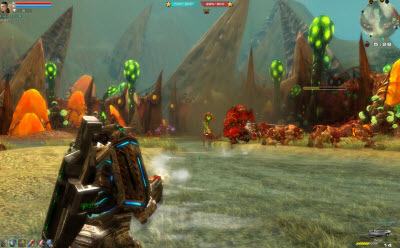
The game combines a unique style of game play with combat between humans and bugs, but we’ll get back to that later. While Battleswarm is an interesting game on its own, the big deal is that it’s the first major game to show off Reality Gap’s MetaTix universal virtual goods system, which has a currency that gamers could use in a bunch of games and which could be licensed for use by any third-party game developer or publisher. The universal virtual goods system may be just the thing to get gamers to do something they rarely do: try out unfamiliar games.
[aditude-amp id="flyingcarpet" targeting='{"env":"staging","page_type":"article","post_id":125705,"post_type":"story","post_chan":"none","tags":null,"ai":false,"category":"none","all_categories":"business,games,","session":"D"}']One MetaTix can be purchased for a penny, though most game transactions are considerably more than that. Gamers can buy and sell equipment and make MetaTix currency in the process, which they can then use in the game or in other MetaTix-based games. You can essentially carry your wallet from game to game, but you can’t cash it out. (If you could cash it out, then Reality Gap would run afoul of various anti-gambling laws).
AI Weekly
The must-read newsletter for AI and Big Data industry written by Khari Johnson, Kyle Wiggers, and Seth Colaner.
Included with VentureBeat Insider and VentureBeat VIP memberships.
The Seattle-based company has now used MetaTix in two games that it got from others. It licensed Monato Esprit from Korean game developer Gamasoft and launched the game in June as a test bed for MetaTix. In that game, users can create their own items and buy and sell them to other players.
The currency system has features such as expiration dates. You can buy a gun such as a flamethrower for $3.50 for a month. After 30 days, it expires and you have to pay again. There’s competition on a variety of fronts. Wild Tangent uses its Wild Coins currency across a bunch of its games, and Microsoft uses Xbox Live points to let users purchase a wide variety of content on its platform.
It will be interesting to see if other game companies license MetaTix. One of the attractions is analytics. MetaTix shows the developer exactly how many people are using its game and what royalties it is entitled to as a result. Developers often have to wait months to find that out. Seven developers have signed up so far, Hood said in an interview.
In the meantime, Battleswarm already has 15,000 players in its initial closed beta test for Battleswarm. The game resembles the sci-fi movie/novel Starship Troopers, where humans square off against fast-moving giant bugs. The bugs operate in real-time strategy mode, where two players hatch hundreds of bugs and send them against the humans; the humans, meanwhile, are each operated by separate players in first-person shooter mode. Each game is a match between two bug players and six human players.
Hood described the game as a “genre-busting” hybrid of two game forms. Hood previously worked at game industry companies such as Capital Entertainment Group and Sierra. Reality Gap has 15 employees, plus a number of contractors. It raised one round of angel funding so far. Rivals include PlaySpan and Live Gamer.
[aditude-amp id="medium1" targeting='{"env":"staging","page_type":"article","post_id":125705,"post_type":"story","post_chan":"none","tags":null,"ai":false,"category":"none","all_categories":"business,games,","session":"D"}']
VentureBeat's mission is to be a digital town square for technical decision-makers to gain knowledge about transformative enterprise technology and transact. Learn More
